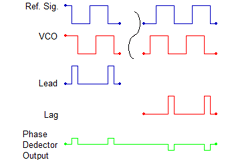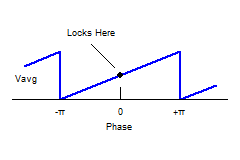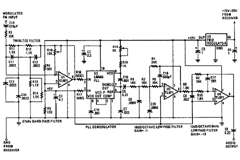|

Figure 1. Classic PLL configuration.
|
The PLL
consists of a Phase Dedector, a Loop Filter, a Voltage Control Oscillator (VCO)
and a Frequency Divider. The phase detector is a device that compares two input
frequencies, generating an output that is a measure of their phase difference
(if, for example, they differ in frequency, it gives a periodic output at the
difference frequency). If fIN doesn't equal fVCO, the
phase-error signal, after being filtered and amplified, causes the VCO
frequency to deviate in the direction of fIN. If conditions are right, the VCO will quickly
"lock" to fIN maintaining a fixed relationship with
the input signal.
The filtered
output of the phase detector is a dc signal, and the control input to the VCO
is a measure of the input frequency, with obvious applications to tone decoding
(used in digital transmission over telephone lines) and FM detection. The VCO
output is a locally generated frequency equal to fIN ,
thus providing a clean replica of fIN, which may itself be noisy.
Since the VCO output can be a triangle wave, sine wave, or whatever, this
provides a nice method of generating a sine wave, say, locked to a train of
pulses. In one of the most common applications of PLLs, a modulo-n counter
as a Frequency Divider is hooked between the VCO output and the phase detector,
thus generating a multiple of the input reference frequency fIN. This
is an ideal method for generating clocking pulses at a multiple of the
power-line frequency for integrating A/D converters (dual-slope,
charge-balancing), in order to have infinite rejection of interference at the
power-line frequency and its harmonics. It also provides the basic technique of
frequency synthesizers.
|
|
A basic
Voltage Controlled Oscillator (VCO) can be seen in Fig. 2. It shows a
basic voltage controlled oscillator by which frequency of oscillation is
determined by L1, C2, and D2. D2 is a so-called varactor or varicap. Most
common diodes will behave as a varicap when reversed biased, but they must be
operated below the junction breakdown parameters. With reverse bias, this diode
will act as a capacitor, its depletion zone forming the dielectric properties.
Changing the amount of reverse bias within the diode's breakdown limits, will
alter the depletion zone width and hence vary the effective capacitance
presented by the diode. This in turn changes the frequency resonance of the
oscillator circuit. Any slight voltage variation in the circuit will cause a
shift in frequency.
If the output
of a VCO and a Crystal Oscillator are fed into a phase detector, being equal in
phase and frequency, there will be no output from the detector. However, if these
signals are different in phase and frequency, the difference is
converted to a DC output signal. The greater the frequency or phase difference
in the two signals, the larger the output voltage. Suppose this DC voltage is
fed back to the Voltage Control Oscillator in such a way that it drives the
output of the VCO towards the Crystal Oscillator frequency--eventually the VCO
will LOCK onto the crystal oscillator frequency. This phenomenon is referred to
as Phase Locked Loop in its most basic form. Only part of the VCO output needs
to be sent to the phase detector. The rest can be usable output.
|

Figure 2. Basic VCO circuit.
|
|

Figure 3. Type I Phase Detector.
|
If used a
divider by n at VCO output then, at LOCK, the VCO would be oscillating instead
of the crystal oscillator frequency at a frequency n times bigger and yet still
be as stable as the crystal reference frequency. There are oscillators that will operate over a large range of
frequencies. Variable Frequency Oscillators (VFO) are made to change frequency
by changing the value of one of the frequency determining circuits. A VCI is
one in which this component is made to change electronically.
There are
actually two basic types of Phase Detectors, sometimes referred to as Type I,
and Type II. The Type I Phase Detector is designed to be driven by analog
signals or digital square-wave signals, whereas the Type II Phase Detector is
driven by digital transitions (edges). They are typified by the most common
used 565 (linear Type I) and the CMOS 4046, which contains both Type I and Type
II. The simplest Phase Detector is the Type I (digital), which is simply an
Exclusive-OR gate (Fig. 3). With low-pass filtering, the graph of the
output voltage versus phase difference is as shown, for input square-waves of
50% duty-cycle. The Type I (linear) Phase Detector has similar output-voltage-versus-phase
characteristics, although its internal circuitry is actually a
"four-quadrant multiplier", also known as a "balanced
mixer". Highly linear Phase Detectors of this type are essential for lock-in
detection, which is a fine technique.
|
|
Todays engineers
face constant challenges in the design of PLL circuits because of the level of
phase noise and the fundamental property of noise floor signals, especially in
the design of radio and wireless networks. More recently, switching speed of
PLL's have become a critical parameter in todays design of synthesizers, and
especially for our modern networks such as 3G, WLANs, WCDMA, and Bluetoothtechnology.
The switching speed is emerging as a challenging requirement forsingle loop, single chip PLL designs. Speed is mainly a function of loop
bandwidth, but in many cases the loop band width cannot be too wide because of
phase noise considerations. Speed-up techniques have been devised to improve
PLL transient time, but most of them have limited efficiency. In addition,
speed-up techniques will have to be improved. For the WCDMA and 3G markets (and
others emerging) a reasonable goal is 100 to 150mS for a dF=60Mhz excursion anda convergence to df=250Hz.
One solution the industry will probably adopt in thefuture is the use of highly complex Sigma Delta fractional PLL architectures,
which allow a high reference frequency and wide loop bandwidth, while
maintaining resolution and a good phase noise profile (low division). This
technique is already being implemented today.
|

Figure 4. Type II Phase Detector.
|
|

Figure 5. Type II Phase Detector output circuit.
|
The type II phase
detector is sensitive only to the relative timing of edges between the
signal and VCO input, as shown in Fig. 4. The phase comparator circuit
generates either lead or lag output pulses, depending on whether
the VCO output transitions occur before or after the transitions of the
reference signal, respectively. The width of these pulses is equal to the time
between the respective edges. The output circuit then either sinks or sources
current (respectively) during those pulses and is otherwise open-circuited,
generating an average output-voltage-versus-phase difference like that in Fig.
5. This is completely independent of the duty cycle of the input signals,
unlike the situation with the type I phase comparator discussed earlier.
Another nice feature of this phase detector is the fact that the output pulses disappear entirely when the two signals are in lock. This means that there is
no "ripple" present at the output to generate periodic phase
modulation in the loop, as there is with the type I phase detector. Also, there
is an additional difference between the two kinds phase detectors.
The type I
detector is always generating an output wave, which must then be filtered by
the loop filter. Thus, in a PLL with type I phase detector, the loop filter
acts as a low-pass filter, smoothing this full-swing logic-output signal. There
will always be residual ripple, and consequent periodic phase variations, in
such a loop. In circuits where phase-locked loops are used for frequency
multiplication or synthesis, this adds "phase-modulation sidebands"
to the output signal.
|
|
By contrast,the type II phase detector generates output pulses only when there is a phase
error between the reference and the VCO signal. Since the phase detector output
otherwise looks like an open circuit, the loop filter capacitor then acts as a
voltage-storage device, holding the voltage that gives the right VCO frequency.
If the reference signal moves away in frequency, the phase detector generates a
train of short pulses, charging (or discharging) the capacitor to the new
voltage needed to put the VCO back into lock. The
second-order PLL, serves as the basis for all PLL synthesizer designs and
technology. Most PLL designs, especially for synthesizers where third and
fourth order loops are common, use a different terminology, and deal mainly
with the open loop gain and phase.
To see anexample of a working PLL doing its job, check out the circuit below of Fig.
6. This schematic diagram shows a so-called SCA adapter. The abbreviation "SCA"
stands for Subsidiary Communications Authorization. It
is used for 'hidden' messages, music, etc. on a normal hidden section of the FM
band. It is based on a 67-KHz subcarrier that is placed on a station's main FM
carrier. It is even possible to have multiple subcarriers, some carrying
digital data, audio, data encryption, coded messages, and more. Subcarrier
transmissions have no effect on standard FM mono and stereo bands and are fully
compatible with all existing radios. This circuit can be hooked up to most fm
tuners with a minimum of fuss. Low in cost, it uses just a few readily
available IC's. The use of a Printed Circuit Board for this design is
recommended.
|

Figure 6. SCS adapter for FM Tuners.
|
| |
|
|
© 2007 Dimitrios Porlidas
|